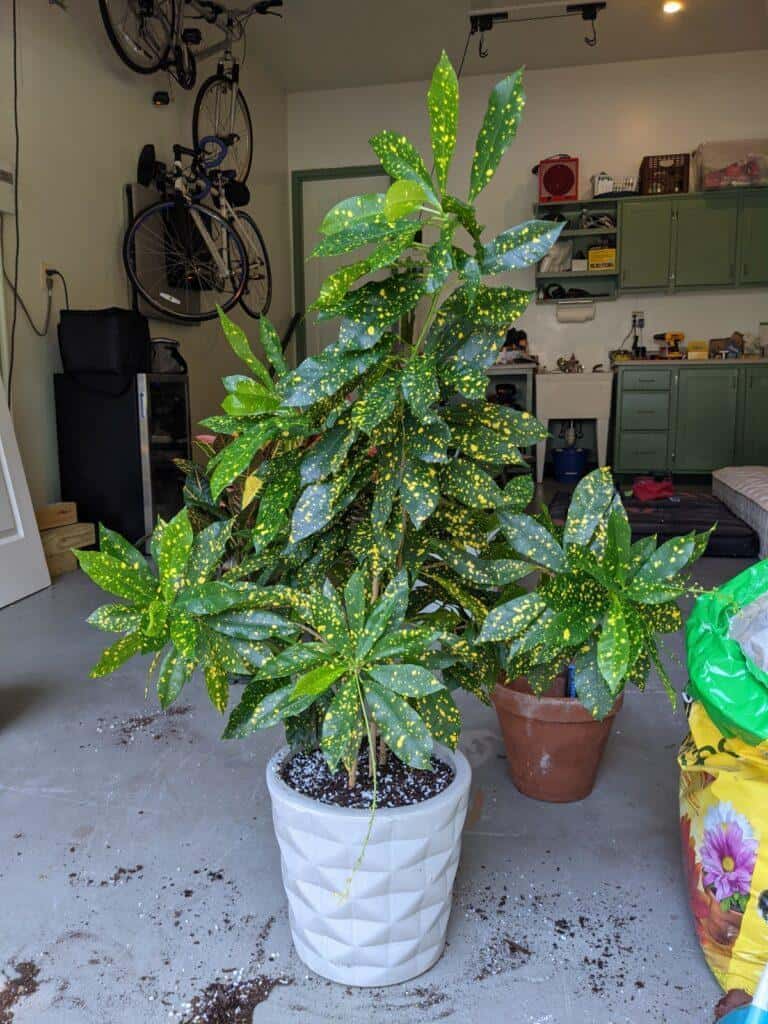Crotons are a popular house plant that you can find at many big box stores or your local nursery. If you’re lucky enough to live in growing zones 9-11, you can also grow them outdoors as a perennial plant. If you live in a lower-numbered zone expect to bring your Croton in for the winter or treat it as an annual. In this post, I’ll go over the basics of Croton Gold Dust plant care.

Croton Gold Dust Plant Care
In my experience, Crotons are fairly easy to care for. The Croton Gold Dust pictured above is one of my older plants. I got it at a Home Depot when it was probably six inches tall and now is about three feet! For those of you looking for the quick basics of indoor Croton care, it can be found in the table directly below. I’ll also go into more detail for each category further below as well. Crotons are not safe for your pets to ingest, so be mindful of where you place them.
| Light Needs | Watering Needs | Soil Needs | Fertilizing Needs |
| Direct or bright indirect light. | The top inch of soil should be dry before watering. | Well draining potting soil. | Every 2- 4 weeks during the growing season. |
Croton Light Requirements
Crotons like the sun. Ample sunlight helps Crotons to produce the vibrantly colored leaves that are their signature. If your Croton is growing leaves but the leaves turn out mostly green, then your Croton is not getting enough light. However, don’t panic if your new leaves appear green they can take a little time to gain their color. Once a leaf has grown to full-size, it should be sporting some colors though.
Croton light requirements are simple. It will do best in the window you get the most sun. In my own home, I’ve kept my Gold Dust Croton in a west-facing window and a south-facing window. It noticeably took off once I put it in the southern window. Windows facing south get the most direct sunlight if you are in the northern hemisphere. If you’re lucky with sunlight, you may be able to get your Croton to Bloom like mine.
If you’re not sure which direction your windows face you should be able to tell by opening up a map app on your phone. However, if you want to know for sure whether your Croton is getting enough light, I like this plant monitor. Most affordable plant light meters on the market give you a single light reading, which can be very inaccurate because you need to know how long the plant is exposed to light. This meter hooks up to an app that gives you the level of light each hour so you know exactly how much light has been accumulated.

Croton Watering
Croton watering can be tricky if you’re like me and like to keep your plants on the dry side. I mainly do this to try to stick to a schedule, but also to prevent fungus gnats who really love moist soil. That said, Crotons like evenly moist soil as well. The general rule you will hear is that you want the top inch of soil to feel dry before you water your Croton.
If you don’t like sticking your finger in the soil all the time and having to clean dirt from your fingernail, I highly suggest a soil moisture meter. This is probably my most used plant tool. It’s definitely made me better at knowing how often to water and how much water to give. If you’re having issues with your Croton leaves like drooping or they’re turning yellow. The first culprit is a watering issue. Check out my blog on yellowing leaves if you think you’re having Croton watering problems.
Croton Fertilizer
Indoor Crotons can be fertilized about every two to four weeks during the growing season. Where growing season means late spring to early fall. Your Croton may grow some new leaves during the winter as an indoor plant, but you don’t really want to encourage it, so refrain from fertilizing.
Your Croton should do fine with an all-purpose balanced fertilizer. A balanced fertilizer is one that has even, or very close to even, ratios of the three nutrients n-p-k. N-P-K is nitrogen-phosphorus-potassium. If you’re really looking to improve foliage growth, then nitrogen is the nutrient for that. If you suspect you have Croton fertilizer issues, you can test using soil rapitests which individually measure nitrogen, phosphorous, potassium, and pH.
Croton Soil
There’s no specific Croton Soil mix that you have to have to keep your Croton happy. Generally speaking, you want a well-draining soil mixture. I usually start with regular potting soil and amend it with a little extra perlite. Perlite is the little white stryofoamy-looking things in potting soil and they help with drainage. I typically use a 4:1 ratio of potting soil to perlite.
The most important thing is that your soil is in a pot that has drainage holes. Using a pot without is asking for trouble in my opinion. If you’re looking into soil, you may be wanting to repot your Croton. I have a step-by-step tutorial on repotting this very plant. These plants are slow growers though so you really only need to repot them every other year or so.
Have questions about Crotons? Let us know in the Comments section below.

I'm a long time plant lover on the quest to happily coexist with as many plants as I can. Let's grow!
